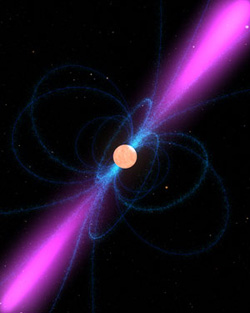Astronomers using the Chandra X-Ray Observatory may have found evidence for a young black hole: it was born in a titanic explosion just 31 years ago.
Black holes form when massive stars explode. The core of the star collapses, and if it’s massive enough (more than about 3 times the mass of the Sun), the gravity of the core can crush it down into a black hole.
Enter Supernova 1979c, a star that exploded in the nearby galaxy M100. About 50 million light years away, M100 is a lovely face-on spiral galaxy in the constellation Coma Berenices. SN1979c was discovered in – duh – 1979, and has been heavily studied for years since it was so bright, making it easy to see.
SN1979c was an interesting event, even for something as mind-numbingly violent as a supernova. The star that exploded was right on the edge of being massive enough to create a black hole; the total mass of the star was about 20 times the mass of the Sun, with a core of just about 3 solar masses. The question is, was the star big enough to create a black hole, or would the core collapse to form an incredibly dense neutron star?
Chandra observations may have answered this question. The way a neutron star emits X-rays is different than that of a black hole. As a neutron star cools, the X-ray emission will fade. However, a black hole blasts out X-rays as material falls in; that stuff forms a flat disk, called an accretion disk, around the black hole. As this matter falls onto the newly created black hole, it gets heated to unimaginable temperatures – millions of degrees – and blasts out X-rays. In that case, the X-rays emitted would be steady over time.
What astronomers have found is that the X-rays from SN1979c have been steady in brightness over observations from 1995 - 2007. This is very strong evidence that the star’s core did indeed collapse into a black hole.
 There is another possibility, though: the X-rays could be generated by a pulsar wind. The neutron star is extremely hot after it’s born, and has an incredibly strong magnetic field. It’s also spinning rapidly. These characteristics make it like a cosmic light house, sending out two beams of energy and matter sweeping around. In this case we call this neutron star a pulsar, because from Earth we see it pulsing as the beams sweep over us. This young pulsar dumps a vast amount of energy into the surrounding material, blowing it outward as a wind (we see this in some pulsars, like the one at the heart of the Crab Nebula). If SN1979c did indeed form a neutron star, it’s possible that could also explain the steady X-rays we see. Only further observations will tell for sure (and I’ll note that the press releases by NASA make it seem a lot more certain this is a black hole, but I think that’s premature; beware of news article making the same claim).
There is another possibility, though: the X-rays could be generated by a pulsar wind. The neutron star is extremely hot after it’s born, and has an incredibly strong magnetic field. It’s also spinning rapidly. These characteristics make it like a cosmic light house, sending out two beams of energy and matter sweeping around. In this case we call this neutron star a pulsar, because from Earth we see it pulsing as the beams sweep over us. This young pulsar dumps a vast amount of energy into the surrounding material, blowing it outward as a wind (we see this in some pulsars, like the one at the heart of the Crab Nebula). If SN1979c did indeed form a neutron star, it’s possible that could also explain the steady X-rays we see. Only further observations will tell for sure (and I’ll note that the press releases by NASA make it seem a lot more certain this is a black hole, but I think that’s premature; beware of news article making the same claim).
Either way, this is an important result for many reasons. One is that we’ve had the math to calculate the borderline mass between a neuron star and black hole for decades, but it’s nice to see the Universe agrees with our calculations. Whether it turns out to be a neutron star or a black hole, the numbers for the mass that astrophysicists have crunched are pretty close; the very fact that this is a borderline object means our math is solid!
Second, we know almost the precise moment this object was born. That helps nail down a lot of the physics. Black holes and neutron stars are objects of immense power, and when they are this young they can change rapidly on a cosmic scale; observations over just a few decades can show large differences in the brightness or energy of the emitted radiation. Knowing the date of birth to within a few days anchors the calculations and models used by scientists to explain the phenomena.
While this result is in some ways maddening – we don’t really know if it’s a young black hole or a young neutron star – it’s the kind of thing astronomers live for. Excellent observations of a landmark object with cutting edge technology are helping to slice ever-finer the dividing line between two of the weirdest objects the Universe makes. And it’s usually in those thin slivers where the fun lies!
Image credit: X-ray: NASA/CXC/SAO/D.Patnaude et al, Optical: ESO/VLT, Infrared: NASA/JPL/Caltech; Pulsar illustration: NASA
Related posts:
- The Crab is still crabby
- Crabby Hubble
- 1300 black holes
- Just how low can a black hole go?